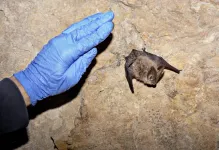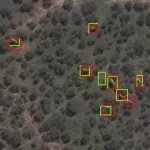New COVID-19 model shows little benefit in vaccinating high-risk individuals first
2021-01-19
(Press-News.org) BROOKLYN, New York, Tuesday, January 19, 2021 - The World Health Organization END
ELSE PRESS RELEASES FROM THIS DATE:
Fastener with microscopic mushroom design holds promise
2021-01-19
WASHINGTON, January 19, 2021 -- A Velcro-like fastener with a microscopic design that looks like tiny mushrooms could mean advances for everyday consumers and scientific fields like robotics.
In Biointerphases, published by AIP Publishing, researchers from Wageningen University in the Netherlands show how the design can use softer materials and still be strong enough to work.
Probabilistic fasteners work, because they are designed with a tiny pattern on one surface that interlocks with features on the other surface. Currently available fasteners, like Velcro and 3M, are called hook and loop fasteners. That design requires harder, stiff material, which ...
Individual and organizational capacity to change can reduce health care workforce burnout
2021-01-19
Even prior to the pandemic, burnout among health care professionals was a pervasive public health concern, with END ...
Land deals meant to improve food security may have hurt
2021-01-19
Large-scale land acquisitions by foreign investors, intended to improve global food security, had little to no benefit, increasing crop production in some areas while simultaneously threatening local food security in others, according to researchers who studied their effects.
The END ...
Even a small amount of gender bias in hiring can be costly to employers
2021-01-19
CORVALLIS, Ore. - Tiny amounts of gender bias in employee hiring decisions contribute to concerning rates of discrimination and productivity losses that together represent significant costs, financial and otherwise, for employers, a new study from Oregon State University has found.
Gender bias is a subtle, unintentional preference for one gender over the other. Despite significant efforts to reduce bias in hiring over the last several decades, it continues to persist and pose potential problems for companies, said Jay Hardy, an assistant professor of management in OSU's College ...
Disease threatens to decimate western bats
2021-01-19
BOZEMAN, Montana (January 19, 2021) - A four-year study recently published in Ecology and Evolution concludes that the fungal disease, white-nose syndrome, poses a severe threat to many western North American bats.
Since it was first detected in 2006, white-nose syndrome has killed millions of bats in eastern and central North America. The spread of the fungal pathogen that causes white-nose syndrome in hibernating bats has reached several western U.S. states, mostly likely through bat-to-bat spread, and is presently threatening western species.
Bats with white-nose syndrome have fungus growing on their nose and wings, as the name implies, but the fungal infection also triggers a higher frequency of arousals from hibernation. ...
Where do our minds wander? Brain waves can point the way
2021-01-19
Anyone who has tried and failed to meditate knows that our minds are rarely still. But where do they roam? New research led by UC Berkeley has come up with a way to track the flow of our internal thought processes and signal whether our minds are focused, fixated or wandering.
Using an electroencephalogram (EEG) to measure brain activity while people performed mundane attention tasks, researchers identified brain signals that reveal when the mind is not focused on the task at hand or aimlessly wandering, especially after concentrating on an assignment.
Specifically, increased alpha brain waves were detected in the prefrontal cortex of ...
Counting elephants from space
2021-01-19
For the first time, scientists have successfully used satellite cameras coupled with deep learning to count animals in complex geographical landscapes, taking conservationists an important step forward in monitoring populations of endangered species.
For this research, the satellite Worldview 3 used high-resolution imagery to capture African elephants moving through forests and grasslands. The automated system detected animals with the same accuracy as humans are able to achieve.
The algorithm that enabled the detection process was created by Dr Olga Isupova, a computer scientist at the University of Bath in the UK. The project was a collaboration with the UK's University of Oxford and the University of Twente in the Netherlands.
Dr ...
5G doesn't cause COVID-19, but the rumor it does spread like a virus
2021-01-19
People's fear of 5G technology is rational. Such technology does emit radiation, even if it's at low levels. But 5G isn't all that different from 4G, and it certainly doesn't cause COVID-19 despite such rumors having spread rapidly across the globe.
Researchers need to better understand how misinformation like this spreads in order to hone their intervention efforts and prevent misinformed perspectives from taking root. In society's virtual world, preventing technological misinformation, in particular, is important now more than ever.
A research team led by Elaine Nsoesie, a Hariri Institute Faculty Fellow, investigated how COVID-19 misinformation proliferated using ...
Study in twins identifies fecal microbiome differences in food allergies
2021-01-19
A new study out of the University of Chicago and Stanford University on pairs of twins with and without food allergies has identified potential microbial players in this condition. The results were published on Jan. 19 in the Journal of Clinical Investigation.
The study grew out of prior research in the Nagler laboratory at UChicago on the fecal microbiota in infants. By transplanting fecal microbes from healthy and food-allergic infants to germ-free mice (who do not possess a microbiome), investigators found that the healthy infant microbiota was protective against the development ...
New clues help explain why PFAS chemicals resist remediation
2021-01-19
The synthetic chemicals known as PFAS, short for perfluoroalkyl and polyfluoroalkyl substances, are found in soil and groundwater where they have accumulated, posing risks to human health ranging from respiratory problems to cancer.
New research from the University of Houston and Oregon State University published in Environmental Science and Technology Letters suggests why these "forever chemicals" - so called because they can persist in the environment for decades - are so difficult to permanently remove and offers new avenues for better remediation practices.
The work focused on the interactions sparked when firefighters use ...




